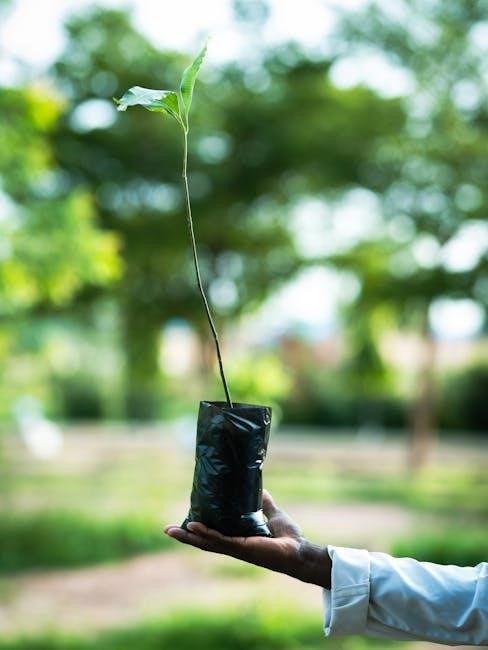Southern California’s climate is characterized by warm, dry summers and mild, wet winters, influenced by its coastal and inland geography, creating diverse microclimates across the region.
1.1 Overview of the Mediterranean Climate
Southern California experiences a Mediterranean climate, characterized by warm, dry summers and mild, wet winters. This climate type supports diverse plant life, with coastal areas enjoying cooler temperatures and inland regions experiencing hotter conditions. The dry summer months necessitate drought-tolerant plants, while the mild winters allow year-round planting opportunities. Understanding this climate is essential for selecting plants that thrive in these conditions, ensuring successful gardening in Southern California’s unique environment.
1.2 Understanding Weather Patterns in Southern California
Southern California’s weather is influenced by the Pacific Ocean, creating cool, moist coastal conditions and hot, dry inland temperatures. Seasonal variations include hot, dry summers with frequent droughts and mild, wet winters providing most of the region’s rainfall. Microclimates vary widely, with coastal fog and mountain snowfall contrasting with desert heat. Extreme events like Santa Ana winds and El Niño/La Niña cycles impact plant growth, requiring gardeners to adapt strategies for water management and planting schedules.
1.3 Impact of Climate on Planting
Southern California’s Mediterranean climate presents unique challenges for planting, with hot, dry summers and mild, wet winters. Drought-tolerant plants thrive in these conditions, while others require careful water management. Extreme weather events, like Santa Ana winds, can damage plants, emphasizing the need for strategic planting times and soil preparation. Understanding these climate patterns helps gardeners select resilient plants and implement effective watering schedules, ensuring optimal growth and resource efficiency throughout the year.
Best Plants for Southern California
Southern California’s climate favors drought-tolerant and native plants, such as succulents, California poppies, and lavender, which thrive in dry conditions and require minimal watering, ideal for water conservation.
2.1 Native Plants for Drought Tolerance
Native plants like California poppies, purple sage, and matilija poppy are ideal for Southern California gardens due to their natural drought tolerance. These plants have adapted to the region’s dry climate, requiring minimal watering and thriving in local soil conditions. They also support native pollinators and wildlife, making them environmentally friendly choices. Incorporating native species reduces the need for extensive irrigation, aligning with water conservation efforts while adding vibrant, low-maintenance beauty to gardens.
2.2 Drought-Tolerant Non-Native Plants
Drought-tolerant non-native plants like succulents, such as aloe vera and echeveria, and lantana, are excellent choices for Southern California gardens. These plants have adapted to thrive in dry conditions, reducing water needs without sacrificing beauty. Many non-native species, such as Mediterranean lavender and yucca, also excel in the region’s climate. They offer vibrant colors, attract pollinators, and provide low-maintenance options for gardeners seeking resilience and aesthetic appeal in water-scarce environments.
2.3 Best Vegetables for Southern California Gardens
Southern California’s climate supports a wide variety of vegetables. Tomatoes, peppers, and zucchini thrive in the warm summers, while leafy greens like kale and spinach excel in cooler seasons. Root vegetables such as carrots and radishes grow well in the region’s soil. Beans, cucumbers, and herbs like basil and cilantro also perform exceptionally. Planting seasonally ensures optimal growth, with warm-season crops in spring and cool-season crops in fall, making year-round gardening possible in this versatile climate.
2.4 Popular Flowers and Ornamental Plants
Southern California gardens flourish with vibrant flowers and ornamental plants. Drought-tolerant options like lavender, succulents, and California poppies are ideal for water-conscious landscapes. Roses, marigolds, and geraniums also thrive in the region’s climate. For color and texture, lantana, bougainvillea, and bird of paradise are popular choices. Seasonal blooms like sunflowers and daisies add variety, while low-maintenance grasses and shrubs provide year-round interest. These plants adapt well to the Mediterranean climate, offering beauty and resilience for gardeners.

Seasonal Planting Guide
Southern California’s Mediterranean climate allows gardeners to plant year-round, with each season offering unique opportunities to grow a variety of flora, ensuring vibrant gardens always.
3.1 Spring Planting Tips
Spring is ideal for planting warm-season crops like tomatoes, peppers, and zinnias. Soil preparation is key—amend with compost for fertility. Water deeply but efficiently, avoiding overwatering. Choose drought-tolerant plants to conserve water. Prune existing plants to promote healthy growth. Monitor for pests like aphids and caterpillars, using natural control methods when possible. Take advantage of cooler mornings for planting to reduce stress on seedlings. Mulch around plants to retain moisture and suppress weeds, ensuring a thriving garden throughout the season.
3.2 Summer Planting Recommendations
Summer in Southern California is hot and dry, making it ideal for drought-tolerant plants like succulents and heat-resistant flowers. Plant vegetables such as tomatoes, peppers, and eggplants in well-draining soil. Incorporate compost to improve soil fertility and water retention. Use drip irrigation or soaker hoses for efficient watering. Mulch around plants to protect roots from extreme heat and retain moisture. Consider planting vibrant flowers like marigolds or zinnias for color. Regularly monitor for pests and diseases, which thrive in warm weather.
3.3 Fall Planting Suggestions
Fall in Southern California offers mild temperatures, making it an ideal time to plant cool-season crops. Vegetables like broccoli, kale, and spinach thrive in the cooler weather. Plant perennials such as lavender and roses, which benefit from the fall season. Bulbs like daffodils and garlic can also be planted now for spring blooms and harvest. Incorporate compost into the soil to enhance fertility and water retention. Mulch around plants to protect roots from cooling temperatures and retain moisture.
3.4 Winter Planting Ideas
Winter in Southern California offers a mild climate, ideal for planting cool-season crops. Root vegetables like carrots, beets, and radishes thrive, as do leafy greens such as lettuce, spinach, and kale. Herbs like parsley and cilantro also grow well. Bulbs like tulips and daffodils can be planted for spring blooms. Incorporate compost into the soil to enrich it, and mulch around plants to protect roots from cooler temperatures. This season is perfect for preparing beds for spring growth and enjoying fresh produce year-round.

Soil Preparation and Management
Soil preparation is crucial for thriving plants in Southern California’s Mediterranean climate. Understanding soil types and amending them properly ensures optimal drainage, nutrient availability, and root health.
4.1 Understanding Soil Types in Southern California
Southern California’s soil varies significantly, with common types including sandy, clay, and loamy soils. Coastal regions often have sandy or well-draining soils, while inland areas may have denser clay soils. Understanding your soil type is essential for planting, as it affects drainage, nutrient retention, and root growth. Regional variations due to climate and geography further diversify soil conditions, requiring tailored approaches for different areas.
4.2 How to Amend Soil for Better Growth
Amend soil by incorporating organic matter like compost, manure, or mulch to enhance fertility and structure. These additions improve water retention in sandy soils and drainage in clay soils. Seasonal applications based on soil tests ensure optimal nutrient balance. This promotes healthy root growth and plant vitality, tailored to Southern California’s diverse soil types.
4.3 Importance of Soil Testing
Soil testing is crucial for understanding soil composition, pH levels, and nutrient availability. It identifies deficiencies and contaminants, guiding targeted amendments and fertilization. Regular testing ensures optimal growing conditions, promoting healthy plant growth and maximizing crop yields. This data-driven approach helps gardeners make informed decisions, enhancing soil health and plant productivity in Southern California’s diverse soil types.
Water Conservation and Efficient Irrigation
Water conservation is vital in Southern California due to dry climates. Efficient irrigation systems and drought-friendly practices help manage water resources sustainably, ensuring plant health and environmental balance.
5.1 Drought-Friendly Watering Tips
Water plants during early morning or evening to minimize evaporation. Use soaker hoses or drip irrigation for efficiency. Check soil moisture by inserting a finger or stick. Water deeply but infrequently to encourage deep root growth. Group plants with similar water needs. Apply mulch to retain soil moisture. Avoid overwatering, as it can harm plants and waste water. Use rain barrels to collect and reuse rainwater. Adjust watering schedules seasonally to match plant needs and weather conditions.
5.2 Efficient Irrigation Systems for Gardens
Install drip irrigation systems to deliver water directly to roots, reducing runoff and evaporation. Use weather-smart sprinklers with sensors to adjust watering based on rainfall and humidity. Consider low-flow sprinkler heads for efficient coverage. Implement timers or smart controllers to automate and optimize watering schedules. Incorporate rainwater harvesting systems to reuse collected water. Regularly inspect and maintain irrigation systems to fix leaks and ensure proper function. These systems help conserve water while keeping plants healthy and thriving.
5.3 Rainwater Harvesting Techniques
Rainwater harvesting is a sustainable way to collect and store rain for garden use. Install rooftop collection systems with barrels or tanks to gather runoff. Use first flush devices to remove debris before water enters storage. Filter collected water to ensure quality for plants. Apply rainwater directly to soil or integrate it with drip irrigation systems. Check local regulations for compliance. Regular maintenance ensures systems remain clean and functional, making rainwater a reliable resource for Southern California gardens;
Common Pests and Weeds in Southern California
Southern California gardens often face pests like aphids, whiteflies, and spider mites, as well as invasive weeds such as dandelions and crabgrass, requiring proactive management strategies.
6.1 Identifying Common Garden Pests
Southern California gardens are susceptible to pests like aphids, whiteflies, spider mites, and mealybugs, which can damage plants by feeding on sap or leaves. Snails and slugs also thrive in moist environments, chewing holes in foliage. These pests often leave behind signs such as sticky honeydew, yellowing leaves, or visible egg clusters. Early identification is crucial for effective management, as infestations can quickly escalate if left unchecked, impacting plant health and productivity.
6.2 Natural Pest Control Methods
Natural pest control methods are essential for maintaining a healthy garden ecosystem. Introduce beneficial insects like ladybugs and lacewings to prey on common pests. Neem oil and insecticidal soap are effective organic solutions to deter aphids and mites. Physical barriers, such as fine-mesh covers, protect plants from whiteflies and beetles. Encourage natural predators and use traps to monitor pest activity. These methods promote a balanced ecosystem, reducing reliance on chemical pesticides and fostering sustainable gardening practices in Southern California.
6.3 Managing Weeds Effectively
Effective weed management is crucial for a thriving Southern California garden. Mulching and hand-weeding are simple yet effective methods to suppress weed growth. Pre-emergent herbicides can prevent weeds from germinating. Regular watering and fertilizing of desired plants help them outcompete weeds. Physical barriers, like landscaping fabric, can also inhibit weed growth. Consistent monitoring and removal of weeds before they seed are key to maintaining a healthy, weed-free garden. These practices ensure your plants receive optimal water and nutrients.

Garden Maintenance Tips
Regular watering, soil monitoring, and natural pest control are essential for maintaining a healthy Southern California garden. Tools and inspections also play a crucial role in upkeep.
7.1 Regular Pruning and Trimming
Regular pruning and trimming are vital for maintaining healthy plant growth in Southern California. Pruning promotes airflow, reducing fungal diseases, while trimming enhances plant shape and encourages blooming. Use sharp tools like pruning shears or loppers to avoid damaging plants. Prune dormant plants in winter and flowering ones after blooms fade. This practice also helps control pests and improves sunlight penetration, ensuring vibrant and thriving gardens year-round.
7.2 Mulching for Soil Health
Mulching is essential for maintaining soil health in Southern California gardens. It retains moisture, reduces evaporation, and suppresses weeds. Organic mulches like wood chips, bark, or straw decompose over time, enriching the soil with nutrients. Apply a thin layer (2-3 inches) to avoid overheating the soil. Mulching also regulates soil temperature, protecting roots from extreme heat or cold. This practice reduces the need for frequent watering and fertilization, promoting a healthier and more sustainable garden environment.
7.3 Seasonal Cleanup and Planning
Seasonal cleanup and planning are crucial for maintaining a thriving Southern California garden. Regularly remove dead plants, weeds, and debris to prevent pests and diseases. Compost organic materials to enrich soil for future plantings. Plan ahead by selecting plants suited to the upcoming season and rotating crops to maintain soil fertility. Clean and prepare gardening tools for the next growing cycle. This process ensures a healthy transition between seasons and maximizes garden productivity year-round.

Tools and Equipment for Planting
Essential tools for Southern California gardening include gloves, trowels, pruning shears, rakes, and watering cans. These items help maintain plant health and simplify tasks efficiently.
8.1 Essential Gardening Tools
Gardening in Southern California requires a variety of tools to ensure success. Essential items include gloves for hand protection, trowels for planting, and pruning shears for trimming plants. Rakes are useful for soil preparation, while watering cans or hoses with spray nozzles help conserve water. A garden cart or wheelbarrow is handy for transporting plants and mulch. These tools not only simplify tasks but also promote efficient gardening practices, especially in the region’s dry climate.
8.2 How to Choose the Right Equipment
Selecting the right gardening equipment is crucial for efficient planting in Southern California. Opt for tools made from durable materials like stainless steel or high-quality plastic to withstand the region’s sun and pests. Consider the specific needs of your plants—drought-tolerant species may require different care tools than water-loving varieties. Invest in a watering system that promotes efficiency, such as soaker hoses or drip irrigation, to conserve water. Choose tools that are ergonomic and versatile to handle multiple tasks effectively.
8.3 Tool Maintenance Tips
Proper tool maintenance is essential for longevity and efficiency in Southern California gardens. Clean tools after each use to prevent dirt buildup and rust. Store them in shaded, dry areas to avoid sun damage. Apply rust inhibitors or oil to metal surfaces regularly. Sharpen blades periodically to ensure optimal performance. Replace worn handles or parts promptly to maintain functionality. Regular maintenance ensures your gardening tools remain reliable and effective for years of planting and care.
Resources for Southern California Gardeners
Explore local nurseries, online forums, and gardening guides tailored to Southern California’s unique climate for expert advice, tools, and plant recommendations.
9.1 Local Nurseries and Gardening Stores
Local nurseries and gardening stores in Southern California offer a wide variety of plants, tools, and expert advice tailored to the region’s climate. These stores often specialize in drought-tolerant species, organic gardening products, and seasonal plants. Many provide workshops and consultations, helping gardeners make informed decisions. Whether you’re a beginner or an experienced gardener, these local resources are invaluable for creating thriving gardens that suit Southern California’s unique conditions.
9.2 Online Communities and Forums
Online communities and forums dedicated to Southern California gardening offer valuable resources and support. Gardeners share advice, experiences, and recommendations tailored to the region’s climate. These platforms foster connections among enthusiasts, providing tips on plant selection, soil management, and pest control. They also feature discussions on seasonal trends and sustainable practices, making them indispensable for both newcomers and seasoned gardeners seeking to enhance their gardening skills and knowledge.
9.3 Recommended Gardening Guides
Recommended gardening guides for Southern California provide tailored advice for the region’s unique climate. Popular books and online resources offer insights into plant selection, soil preparation, and seasonal care. Many guides focus on drought-tolerant and native plants, while others emphasize sustainable practices. Websites like the California Native Plant Society and local nursery publications are excellent resources. These guides help gardeners make informed decisions, ensuring successful and thriving gardens in Southern California’s diverse conditions.
